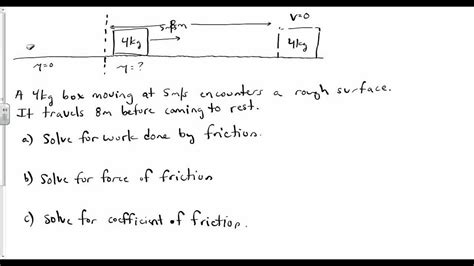Friction is a force that opposes motion between two surfaces in contact. It is a non-conservative force, meaning that it does not conserve energy. The work done by friction is the energy that is lost due to friction.

Calculating Work Done by Friction
The work done by friction is given by the following equation:
W = F * d
where:
- W is the work done by friction (in joules)
- F is the force of friction (in newtons)
- d is the distance over which the force acts (in meters)
Measuring Force of Friction
The force of friction can be measured using a variety of methods, including:
- Inclined plane method: This method involves placing an object on an inclined plane and measuring the angle at which the object begins to slide. The force of friction is equal to the component of the object’s weight that is parallel to the plane.
- Coefficient of friction method: This method involves measuring the coefficient of friction between two surfaces. The coefficient of friction is a dimensionless number that represents the ratio of the force of friction to the normal force between the surfaces.
- Dynamometer method: This method involves using a dynamometer to measure the force required to move an object across a surface.
Applications of Work Done by Friction
The work done by friction has a variety of applications, including:
- Braking: Friction is used to slow down and stop vehicles. The brake pads on a car create friction with the brake rotors, which converts the kinetic energy of the vehicle into heat.
- Traction: Friction is necessary for vehicles to move. The tires of a car create friction with the road, which allows the car to accelerate and turn.
- Lubrication: Lubricants are used to reduce friction between surfaces. This can improve the efficiency of machines and reduce wear and tear on components.
Benefits of Reducing Friction
Reducing friction can have a number of benefits, including:
- Increased efficiency: Reducing friction can improve the efficiency of machines and systems. This can lead to reduced energy consumption and improved performance.
- Reduced wear and tear: Reducing friction can reduce wear and tear on components. This can extend the lifespan of machines and reduce maintenance costs.
- Improved safety: Reducing friction can improve safety. For example, reducing friction on the brake pads of a car can improve braking performance and reduce the risk of accidents.
Tips and Tricks for Reducing Friction
There are a number of ways to reduce friction, including:
- Use lubricants: Lubricants can reduce friction between surfaces. There are a variety of lubricants available, including oils, greases, and powders.
- Use smooth surfaces: Smooth surfaces have less friction than rough surfaces. This is because smooth surfaces have fewer irregularities that can cause friction.
- Increase the normal force: The normal force is the force that presses two surfaces together. Increasing the normal force can reduce friction. This can be done by adding weight to the object or by increasing the pressure between the surfaces.
Step-by-Step Approach to Calculating Work Done by Friction
- Identify the force of friction acting on the object.
- Measure the distance over which the force acts.
- Calculate the work done by friction using the equation W = F * d.
Real-World Examples of Work Done by Friction
- Walking: Friction between the soles of your shoes and the ground allows you to walk.
- Driving: Friction between the tires of your car and the road allows you to drive.
- Braking: Friction between the brake pads and the brake rotors slows down and stops your car.
- Lubricating: Lubricants reduce friction between moving parts in engines and other machines.
Why Work Done by Friction Matters
Work done by friction is important because it can affect the efficiency, safety, and performance of machines and systems. By understanding how to calculate and reduce friction, you can improve the performance of your machines and systems and save money.
Conclusion
Work done by friction is a non-conservative force that opposes motion between two surfaces in contact. It is important to understand how to calculate and reduce friction in order to improve the efficiency, safety, and performance of machines and systems.
